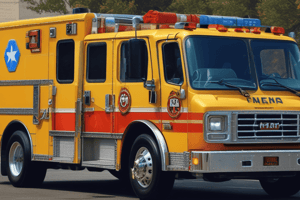Podcast
Questions and Answers
Who should evaluate the site for suitability of a MEDIVAC helicopter landing zone?
Who should evaluate the site for suitability of a MEDIVAC helicopter landing zone?
- The Incident Commander
- The LZ Coordinator (correct)
- The aeromedical unit
- The ECC
What is the determining factor for the need of aeromedical response?
What is the determining factor for the need of aeromedical response?
- The type of injury
- The patient's age
- The availability of ground transportation
- Transport time and patient need (correct)
What are the criteria for aeromedical transport?
What are the criteria for aeromedical transport?
- Various injuries and transport time to a trauma center (correct)
- Patient's preference
- Patient's insurance coverage
- Patient's level of consciousness
Who makes contact with the requested aeromedical unit and provides necessary information?
Who makes contact with the requested aeromedical unit and provides necessary information?
What should personnel do after the aircraft has departed from the landing zone?
What should personnel do after the aircraft has departed from the landing zone?
What information should be included in the Helispot report?
What information should be included in the Helispot report?
Who should be appointed as the LZ Coordinator?
Who should be appointed as the LZ Coordinator?
What should personnel do to prepare the LZ for the MEDIVAC helicopter?
What should personnel do to prepare the LZ for the MEDIVAC helicopter?
What should personnel do to protect themselves from rotor wash during landing and takeoff?
What should personnel do to protect themselves from rotor wash during landing and takeoff?
What should personnel do with loose objects that can be blown into rotor blades?
What should personnel do with loose objects that can be blown into rotor blades?
Flashcards are hidden until you start studying
Study Notes
- The Chesapeake Fire Department has procedures for establishing MEDIVAC helicopter landing zones.
- An LZ Coordinator should be appointed by the Incident Commander.
- The LZ Coordinator should evaluate the site for suitability and confirm with ECC.
- The need for aeromedical response should be determined based on transport time and patient need.
- Criteria for aeromedical transport include various injuries and transport time to a trauma center.
- ECC will make contact with the requested aeromedical unit and provide necessary information.
- Apparatus and personnel should be deployed to prepare the LZ and keep individuals at least 100 feet away.
- The LZ Coordinator should aid the pilot in locating the LZ and advise of any hazards.
- After the aircraft has departed, personnel should remove any LZ markers or landing aides.
- A Helispot report should be provided to the flight crew with location, markings, wind direction, obstructions, and patient information.
- Obtain patient weight and any special conditions.
- Get ETA on helicopter arrival.
- Follow universal practices in LZ operations.
- Do not approach aircraft until directed by pilot.
- Approach and walk away from aircraft from the side only.
- Do not walk around the tail rotor.
- Protect eyes from rotor wash during landing and takeoff.
- Do not carry anything overhead.
- Allow aircraft crew to control activity around the aircraft.
- Secure loose objects that can be blown into rotor blades.
Studying That Suits You
Use AI to generate personalized quizzes and flashcards to suit your learning preferences.




